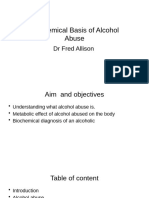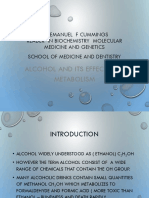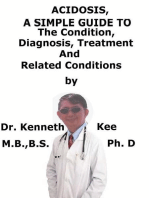V. Alcohol
V. Alcohol
Uploaded by
George TsangCopyright:
Available Formats
V. Alcohol
V. Alcohol
Uploaded by
George TsangOriginal Description:
Original Title
Copyright
Available Formats
Share this document
Did you find this document useful?
Is this content inappropriate?
Copyright:
Available Formats
V. Alcohol
V. Alcohol
Uploaded by
George TsangCopyright:
Available Formats
V.
Alcohol
Given the wide spectrum of alcohol use and
abuse, often starting in teenage years and college
years, knowledge of alcohol consumption and its
relationship to overall health is essential to the
study of nutrition.
Alcohol, chemically known as ethanol, has
played many roles throughout history. Alcohol
contributes energy to the diet, about 7 kcal/g. It
is also a social stimulant because it takes away
inhibitions, it is a thirst quencher when used as a
safe alternative to polluted water, and it is an
analgesic to treat aches and pain.
Alcohol requires no digestion. It is absorbed
rapidly from the GI tract by simple diffusion, no
specific transport mechanisms are required for
alcohol to enter a cell, so it is the most efficiently
absorbed of all energy sources.
ifferent parts of the GI tract absorb alcohol at
different rates. !he upper parts of the small
intestine absorb alcohol fastest, depending on
how quickly the stomach empties, which in turn
depends on the kinds of food consumed along
with the alcohol.
"
A. #ow Alcoholic $everages Are produced
!he microorganism, yeast is responsible for the
alcohol production.
uring glycolysis, glucose is first converted to
pyruvate. %east cells then convert pyruvate to
alcohol and carbon dio&ide in a simple, two'step
process.
In the first step, the ('carbon pyruvate is
converted to the )'carbon acetaldehyde in an
irreversible reaction with the release of *+
)
.
In the second step, another en,yme donates a
pair of hydrogens to acetaldehyde to form
ethanol. !his en,yme uses the $'vitamin niacin
in the form of the coen,yme -A# . #
.
.
/thanol and carbon dio&ide are the end products
of the process.
)
0roduction of Alcohol
Anaerobic condition *+
)
Glucose 0yruvate Acetaldehyde
1ermentation of yeast -A#
2altose -A
.
Amylase
*#+
/thanol
$. Alcohol 2etabolism
After a person drinks an alcoholic beverage, his
or her blood concentration of alcohol rises
rapidly.
(
Alcohol is readily absorbed into the blood from
different segments of the GI tract by simple
diffusion.
Alcohol absorption depends partly on the rate of
stomach emptying. 1ood slows the stomach3s
emptying rate and stimulates secretions, such as
gastric acid, which dilute the alcohol and slow its
absorption into the bloodstream. *ertain drugs
also control stomach'emptying time and thus,
overall absorption.
4
Appro&imate relationship between alcohol consumption and blood alcohol
concentration 5$A*6 units are 7 or mg of alcohol per "88 ml of blood9
Alcohol is readily distributed in all the fluid
compartments within the body because alcohol is
found wherever water is distributed in the body.
:
Alcohol moves easily through the cell
membranes6 however, as it does, it damages
proteins in the membranes.
2ost of alcohol3s damaging effects are
concentrated in the liver because this is the first
organ that is e&posed to alcohol after absorption,
and the liver is the chief site for alcohol
metabolism.
Although it is true that cells of the GI tract are in
contact with alcohol, they are constantly being
replaced because of their naturally short life
span. !hus, they are not sub;ect to the same
degree of damage as liver cells, which have a
much longer life span.
<
2etabolism of alcohol is dependent on numerous
factors, such as gender, race, si,e, physical
condition, what is eaten, the alcohol content of
the beverage, and even how much sleep one has
had.
!he ability to produce the en,yme alcohol
dehydrogenase (ADH) is the key to alcohol
metabolism, as it acts on about =87 of the dose
consumed.
>omen absorb and metaboli,e alcohol
differently then men do. A woman cannot
metaboli,e much alcohol in the cells that line her
stomach because of low activity of A#
>omen also have less body water in which to
dilute the alcohol than do men. ?o, when a
young man and a woman of similar si,e drink
equal amounts of alcohol, a large proportion of
the alcohol reaches and remains in the woman3s
bloodstream.
2en metaboli,e about (87 of the alcohol
ingested in this manner, but women metaboli,e
only "87.
+verall, women develop alcohol'related
ailments, such as cirrhosis of the liver, more
rapidly than men do with the same alcohol'
consumption habits. Also, certain drugs used to
treat ulcers and heartburn inhibit A# activity in
7
the stomach, as does chronic alcohol abuse and
aging.
2ost of the remaining alcohol consumed is then
metaboli,ed in the same way by alcohol
dehydrogenase to carbon dio&ide and water in
the liver. +nly a small percentage of alcohol
intake is e&creted as such through the lungs,
urine, and sweat. ?ince the alcohol content of
e&pired air e&hibits a constant relationship to the
blood alcohol concentration in the lungs, it is
used as the basis of the breathaly,er test.
A social drinker who weighs ":8 pounds and has
normal liver function metaboli,es about : to 7g
of alcohol per hour. !his is about one half of a
beer or one fourth of an ordinary'si,e drink.
>hen the rate of alcohol consumption e&ceeds
the liver3s metabolic capacity, blood alcohol
rises and symptoms of into&ication appear as the
brain begins to be e&posed to alcohol.
$ecause alcohol cannot be stored in the body, it
has absolute priority in metabolism as a fuel
source. >hen needed, the liver also has two
other pathways to metaboli,e alcohol. /ach,
along with alcohol dehydrogenase, produces
acetaldehyde.
@
!he other pathways are the microsomal ethanol
oxidizing system (MEOS) and the en,yme
catalase. !hese other two systems are also active
in other cells in the body.
Alcohol Dehydrogenase Pathway
Alcohol at a low to moderate quantity is
converted to acetaldehyde by the action of
alcohol dehydrogenase and the coen,yme -A
.
.
istinctly different forms of alcohol
dehydrogenase are found in the liver and the
stomach.
/ach varies its rate of alcohol metabolism. !his
en,yme requires the mineral ,inc for activity.
=
Aow to 2oderate /thanol Intake'
A# 0athway
+ccurs in the cytosol6 yields energy
Alcohol dehydrogenase
/thanol Acetaldehyde
-A -A# -A
*oA
-A#
Acetyl'*oA
A!0 *itric Acid *ycle
!he acetaldehyde formed is then converted to
acetyl'*oA.
Microsomal Ethanol Oxidizing System
(MEOS)
At low alcohol intake, the alcohol dehydrogenase
pathway in the cytoplasm is used. At high
alcohol intake, the microsomal ethanol o&idi,ing
system in the cytoplasm also is used.
!he liver 5and other body cells as well9 uses the
2/+? to metaboli,e drugs and other foreign
substances. >hen the liver is overwhelmed with
e&cess amounts of alcohol, it treats the
"8
e&cess as a foreign substance and activates the
2/+?.
2/+? 0athway
!his system uses o&ygen, another niacin
coen,yme 5-A0# . #
.
9, and produces water
and acetaldehyde.
+nce the 2/+? is active, alcohol tolerance
increases because the rate of alcohol metabolism
increases.
!here are two interesting aspects of the body3s
reliance on 2/+?. 1irst, rather than forming the
niacin'containing coen,yme, -A# . #
.
as
with alcohol dehydrogenase, the 2/+? uses the
niacin containing coen,yme -A0# . #
.
.
Bather than yielding CpotentialD A!0 molecules
""
from the first step in alcohol metabolism, the
2/+? uses CpotentialD A!0 energy.
!his partly e&plains why alcoholics do not gain
as much weigh as might be e&pected from the
amount of alcohol'derived energy they consume.
?econd, use of the 2/+? also increases the
potential for a drug overdose. >hile the 2/+?
is metaboli,ing alcohol, the liver3s capacity for
metaboli,ing other drugs, such as many
sedatives, is reduced, since both substrates are
competing for the same en,yme.
If large amount of alcohol and sedatives are
consumed simultaneously, the alcohol gets
preferential treatment. ?ince this means the liver
is not able to metaboli,e the sedatives fast
enough, the user may lapse into a coma and even
die.
atalase
")
*atalase
!he catalase en,yme found in the liver and other
cells contributes to a minor pathway for
metaboli,ing alcohol. It is located in the
pero&isomes.
*atalase
#)+) #)+
/thanol Acetaldehyde
!he catalase en,yme found in the liver and other cells
contributes to a minor pathway for metaboli,ing
alcohol. It is located in the cell organelle, the
pero&isomes.
*. $enefits of 2oderate Alcohol Ese
!he benefits of moderate alcohol use begins with
the many pleasurable and social aspects of its
use.
evelopment of cardiovascular disease and
especially cardiovascular disease'related deaths
such as from coronary heart disease, are lower
for those consume moderate amounts of alcohol.
"(
+f all the alcohol sources, red wine is often
singled out as the best choice because of the
added bonus of the many phytochemicals 5e.g.,
polyphenols, resveratrol..9 present.
!hese were leached out from the grape skins as
the red wine was fermented. Becent studies also
show that beer contains similar phytochemicals,
but a lower amount.
. #ealth 0roblems from Alcohol Abuse
espite the benefits of regular, moderate alcohol
use, the risks of abuse are more numerous and
harmful.
Alcoholism, in and of itself, is the third leading
cause of preventable death in -orth America. In
fact, e&cessive consumption of alcohol
contributes significantly to : of the "8 leading
causes of death in -orth America, heart failure,
certain forms of cancer, cirrhosis of the liver,
motor vehicle and other accidents, and suicides.
!obacco, often used simultaneously, interacts
with alcohol in a way that reinforces its effects
and causes esophageal and oral cancer.
In addition, e&cessive alcohol drinking increases
the risk of heart rhythm disturbances,
"4
hypertension and hemorrhage stroke,
osteoporosis, brain damage, colorectal and breast
cancer, inflammation of the stomach lining,
suppression of the immune system, sleep
disturbances, impotence, hypoglycemia, and
high blood triglycerides.
/ffects of Alcohol
":
!he euphoria that arises from
alcohol use involves alcohol
binding to specific receptors
in the brain. It is likely that
this binding, causes a release
of the neurotransmitter
dopamine. !he increase is
thought to cause the
characteristic high associated
with alcohol use. -altre&one
works by blocking alcohol3s
ability to bind to brain
receptors. !his reduces
dopamine release and blocks
the pleasant feelings elicited
by alcohol use.
"<
$inge rinking
/specially in college students
F 4 or more drinks in a row
Acute alcohol into&ication
?igns of alcohol poisoning
semiconsciousness or unconsciousness
slow respiration 5G@ breathes per min. or more F@
seconds between breath9
cold, clammy, pale, or bluish skin
strong odor of alcohol
"7
You might also like
- Defensive Driving Presentation-PowerPointDocument229 pagesDefensive Driving Presentation-PowerPointmbloex50% (2)
- Autopsy - Shanann WattsDocument16 pagesAutopsy - Shanann Wattsnatasaknez100% (5)
- Driving License Written TestDocument43 pagesDriving License Written TestNeer Hason88% (8)
- The Effect of Storage at Various Temperatures On Blood Alcohol ConcentrationDocument7 pagesThe Effect of Storage at Various Temperatures On Blood Alcohol ConcentrationRosaniza KamarudinNo ratings yet
- Ethnol NotesDocument7 pagesEthnol NotesChandra SekarNo ratings yet
- Complete PaperDocument24 pagesComplete PaperirhammunazatNo ratings yet
- Alcohol Assignment CompleteDocument5 pagesAlcohol Assignment Completeapi-278392762No ratings yet
- Alcohol MetabolismDocument12 pagesAlcohol Metabolismjames100% (1)
- 7.02 Alcohol MetabolismDocument3 pages7.02 Alcohol MetabolismPiyush ChaudharyNo ratings yet
- Alcohol IntroductionDocument2 pagesAlcohol IntroductionPrerana PawarNo ratings yet
- Alcohol in The BodyDocument3 pagesAlcohol in The BodyMarius StancuNo ratings yet
- Removal of Alcohol From The BodyDocument21 pagesRemoval of Alcohol From The BodysmohammedraihanvlllcNo ratings yet
- The Pharmacology of AlcoholDocument8 pagesThe Pharmacology of AlcoholTarii NjNo ratings yet
- Alcohol MetDocument11 pagesAlcohol MetMilkoo sabaNo ratings yet
- A Correlation Between Alcohol Consumption and ObesityDocument15 pagesA Correlation Between Alcohol Consumption and ObesitynikitariNo ratings yet
- Alcohol: Ethanol, Methanol and Ethylene GlycolDocument90 pagesAlcohol: Ethanol, Methanol and Ethylene GlycolNisreen Al-share100% (2)
- 7.03 Health Consequences of Alcohol AbuseDocument3 pages7.03 Health Consequences of Alcohol AbusePiyush ChaudharyNo ratings yet
- Relationships Between Nutrition, Alcohol Use, and Liver DiseaseDocument12 pagesRelationships Between Nutrition, Alcohol Use, and Liver DiseaseRoy Morales PérezNo ratings yet
- DOPOD Alchohol and Abuse 2023Document12 pagesDOPOD Alchohol and Abuse 2023insyed9No ratings yet
- 615833021-Chem-Investigatory-Project 12Document27 pages615833021-Chem-Investigatory-Project 12songaraharshitNo ratings yet
- Chem Investigatory ProjectDocument27 pagesChem Investigatory ProjectRoshini Gopusankar50% (2)
- Alcohol PDFDocument10 pagesAlcohol PDFPooja YadavNo ratings yet
- Alcohol AbuseDocument44 pagesAlcohol AbuseazagbugNo ratings yet
- How to increase testosterone while drinking alcoholDocument14 pagesHow to increase testosterone while drinking alcoholDavid SevaNo ratings yet
- Chemistry Module 4&%Document11 pagesChemistry Module 4&%angelo aquinoNo ratings yet
- Alcohol AbuseDocument19 pagesAlcohol AbuseMekhi ReidNo ratings yet
- Alcohol MetDocument11 pagesAlcohol MetHasen umerNo ratings yet
- Basic Pharmacology of EthanolDocument7 pagesBasic Pharmacology of EthanoltemitopeNo ratings yet
- Trabajo AlcoholismoDocument7 pagesTrabajo AlcoholismoJavier Andrés HualveNo ratings yet
- Flow of Poison in The BodyDocument16 pagesFlow of Poison in The BodyGiselle TapawanNo ratings yet
- Questions To Consider:: Ethylene Glycol Poisoning. Ethylene Glycol Chemically Occupies A Position Between EthylDocument4 pagesQuestions To Consider:: Ethylene Glycol Poisoning. Ethylene Glycol Chemically Occupies A Position Between EthylJeanette Miña GrajoNo ratings yet
- Chemistry-Science of AlcoholDocument16 pagesChemistry-Science of AlcoholSiya SamriddhiNo ratings yet
- Chemistry Module 4&5Document11 pagesChemistry Module 4&5angelo aquinoNo ratings yet
- Forensic Lab 13.1 Blood Alcohol Ham PDFDocument9 pagesForensic Lab 13.1 Blood Alcohol Ham PDFwalt richardsNo ratings yet
- Alcohol INFO For PilotsDocument6 pagesAlcohol INFO For PilotsmartinNo ratings yet
- Effect of Alcohol On Liver and Alcohol Liver Disease PathologyDocument11 pagesEffect of Alcohol On Liver and Alcohol Liver Disease PathologySamir BattaNo ratings yet
- Alcohol Metabolism ReportDocument25 pagesAlcohol Metabolism ReportRhea Andrea UyNo ratings yet
- None 176bd100Document5 pagesNone 176bd100sumnelviraNo ratings yet
- Alcohol Intoxication Definition and CausesDocument7 pagesAlcohol Intoxication Definition and CausesRjay Cantos100% (1)
- ID Plastics and Glarttg45ss LabDocument10 pagesID Plastics and Glarttg45ss Labwalt richardsNo ratings yet
- Fluid Electrolyte and AcidBase BalanceDocument33 pagesFluid Electrolyte and AcidBase Balancemoncalshareen3No ratings yet
- Pharma Katzung - AlcoholsDocument5 pagesPharma Katzung - AlcoholsJoshua RemonNo ratings yet
- Ethanol and Fructose MetabolismDocument24 pagesEthanol and Fructose MetabolismpiriyalakanNo ratings yet
- Wardlaws Perspectives in Nutrition 10th Edition Byrd-Bredbenner Solutions Manual DownloadDocument12 pagesWardlaws Perspectives in Nutrition 10th Edition Byrd-Bredbenner Solutions Manual DownloadLorraine Jones100% (19)
- AlcoholDocument28 pagesAlcoholpl.wsei.lublinNo ratings yet
- Alcohol and Its Effects On MetabolismDocument50 pagesAlcohol and Its Effects On MetabolismLeonard BowenNo ratings yet
- Presence of Glucose and Protein in The Urine Samples of Alcoholics 1Document25 pagesPresence of Glucose and Protein in The Urine Samples of Alcoholics 1ROBERT TOMARONo ratings yet
- Fluids and Electrolytes A Fast and Easy Way To Understand Acid-Base Balance Without MemorizationDocument195 pagesFluids and Electrolytes A Fast and Easy Way To Understand Acid-Base Balance Without MemorizationNayely MoralesNo ratings yet
- Alcohol Metabolism 2Document3 pagesAlcohol Metabolism 2kristal eliasNo ratings yet
- Chemistry Send FileDocument16 pagesChemistry Send FilenitinNo ratings yet
- Proteins Experiment 2 Guide QuestionsDocument3 pagesProteins Experiment 2 Guide QuestionsRuchie Ann Pono BaraquilNo ratings yet
- ALKOHOL - MetabolizamDocument10 pagesALKOHOL - MetabolizamJuoc HrijebarNo ratings yet
- ALcohol MetabolismDocument17 pagesALcohol MetabolismMaharij NoorNo ratings yet
- Presence of Glucose and Protein in The Urine Samples of Alcoholics 1Document25 pagesPresence of Glucose and Protein in The Urine Samples of Alcoholics 1Robert Kier Tanquerido TomaroNo ratings yet
- Alcoholic Live DiseaseDocument53 pagesAlcoholic Live DiseaseKuldeep SinghNo ratings yet
- S. Yogesh- AlcoholismDocument14 pagesS. Yogesh- Alcoholismskpoovarasan411No ratings yet
- Chapter 5Document4 pagesChapter 5Rafael G. Garcia SanchezNo ratings yet
- College Municipal 3ème 3Document2 pagesCollege Municipal 3ème 3Guillaume Olivier DjadouNo ratings yet
- Substance Use and Abuse For Students 2018-2019Document50 pagesSubstance Use and Abuse For Students 2018-2019ZauraNo ratings yet
- Chronic Physical Effects of Alcoholism: I. General AppearanceDocument8 pagesChronic Physical Effects of Alcoholism: I. General AppearanceVarun SharmaNo ratings yet
- Why To Study Alcohols in Pharmacology?Document4 pagesWhy To Study Alcohols in Pharmacology?Ronald DarwinNo ratings yet
- Acidosis, A Simple Guide To The Condition, Diagnosis, Treatments And Related ConditionsFrom EverandAcidosis, A Simple Guide To The Condition, Diagnosis, Treatments And Related ConditionsNo ratings yet
- Modded Tube ScreamerDocument5 pagesModded Tube ScreamerGeorge TsangNo ratings yet
- Plant Bio Review Ver 2Document9 pagesPlant Bio Review Ver 2George TsangNo ratings yet
- HUMA 2104 - Intro To Music Theory: Let's Talk About NotationDocument13 pagesHUMA 2104 - Intro To Music Theory: Let's Talk About NotationGeorge TsangNo ratings yet
- Concert Report GuidelinesDocument2 pagesConcert Report GuidelinesGeorge TsangNo ratings yet
- Ecotoxicology Course Description: Course Intended Learning OutcomesDocument1 pageEcotoxicology Course Description: Course Intended Learning OutcomesGeorge TsangNo ratings yet
- 7) Cork, Cork Cambium and Periderm, Identify The Structure Part B, 18% (53 Trees)Document1 page7) Cork, Cork Cambium and Periderm, Identify The Structure Part B, 18% (53 Trees)George TsangNo ratings yet
- Tube ScreamerDocument8 pagesTube ScreamerJake WoodNo ratings yet
- ReportDocument1 pageReportGeorge TsangNo ratings yet
- Neuroview: How To Pick A Graduate AdvisorDocument5 pagesNeuroview: How To Pick A Graduate AdvisorGeorge TsangNo ratings yet
- Amino Acids As PrecursorsDocument4 pagesAmino Acids As PrecursorsGeorge TsangNo ratings yet
- Morphology: Morpheme Word Free A Constant Shape and MeaningDocument6 pagesMorphology: Morpheme Word Free A Constant Shape and MeaningGeorge TsangNo ratings yet
- Chapter 12: The Trace (Micro) MineralsDocument19 pagesChapter 12: The Trace (Micro) MineralsGeorge TsangNo ratings yet
- Characteristics of The Chinese Language3Document4 pagesCharacteristics of The Chinese Language3George TsangNo ratings yet
- Chinese Morphology 6Document3 pagesChinese Morphology 6George TsangNo ratings yet
- Characteristics of The Chinese Language4Document3 pagesCharacteristics of The Chinese Language4George TsangNo ratings yet
- Project ReportDocument3 pagesProject ReportGeorge TsangNo ratings yet
- HUMA1030 Structure of The Chinese LanguageDocument7 pagesHUMA1030 Structure of The Chinese LanguageGeorge TsangNo ratings yet
- Characteristics of The Chinese Language2Document2 pagesCharacteristics of The Chinese Language2George TsangNo ratings yet
- Alcohol, Drugs, and Impaired Driving-Forensic Science and Law Enforcement Issues 1st Edition A. Wayne Jones (Editor)Document52 pagesAlcohol, Drugs, and Impaired Driving-Forensic Science and Law Enforcement Issues 1st Edition A. Wayne Jones (Editor)popvefosNo ratings yet
- Bartending Summative q2Document6 pagesBartending Summative q2Julie Mae DayujaNo ratings yet
- English Korean Law GlossaryDocument31 pagesEnglish Korean Law GlossaryAinul FatihahNo ratings yet
- Responsible Alcohol DrinkingDocument2 pagesResponsible Alcohol DrinkingMikka LazatinNo ratings yet
- 10 AmperDocument54 pages10 AmperPy LabNo ratings yet
- DWI April May 2010Document2 pagesDWI April May 2010Albuquerque JournalNo ratings yet
- The Main Factors That Cause Car AccidentDocument3 pagesThe Main Factors That Cause Car AccidentIvanNo ratings yet
- Drivers Licence ReviewDocument7 pagesDrivers Licence ReviewJennifer Regala Y CometâNo ratings yet
- REFORM IbookDocument32 pagesREFORM IbookpoenaruzzzNo ratings yet
- Blood Alcohol ContentDocument6 pagesBlood Alcohol ContentGina Monserrat Gamboa NezNo ratings yet
- Pyq ToxicoDocument5 pagesPyq ToxicoLeeshaaLenee Paramanantha KumarNo ratings yet
- 5-1-08 - Vanishing Liquid - Discrepant EventDocument3 pages5-1-08 - Vanishing Liquid - Discrepant Eventad_dinNo ratings yet
- Breath Alcohol Tester WGSensorDocument40 pagesBreath Alcohol Tester WGSensorbrunowangNo ratings yet
- Jul Aug09Document2 pagesJul Aug09Albuquerque JournalNo ratings yet
- Alcohol Detection With Engine Locking (PPT) - 1Document19 pagesAlcohol Detection With Engine Locking (PPT) - 1Chotu Chotu100% (1)
- q4 DLL Health 8 wk1 4 ErverfvqefvDocument9 pagesq4 DLL Health 8 wk1 4 Erverfvqefvmeriam.nool002No ratings yet
- Ateneo VSDocument4 pagesAteneo VSLenz Meret CataquisNo ratings yet
- Note GuideDocument2 pagesNote GuideDemetrius Hobgood0% (1)
- WM4 User ManualDocument44 pagesWM4 User ManualpcatruongNo ratings yet
- Forensic Toxicology CH 6pptDocument22 pagesForensic Toxicology CH 6pptRaymark CarinoNo ratings yet
- Drug Educ Vice ControlDocument58 pagesDrug Educ Vice ControlRoss Sally100% (1)
- Alcohol and PoisoningDocument57 pagesAlcohol and PoisoningMpho MosehlaNo ratings yet
- Questionnaires For PROFESSIONAL DRIVER'S LICENSE APPLICANTS (LIGHT VEHICLES) PDFDocument19 pagesQuestionnaires For PROFESSIONAL DRIVER'S LICENSE APPLICANTS (LIGHT VEHICLES) PDFRandy Navida100% (1)
- Kirgisistan, Proposed Road Safety StrategyDocument88 pagesKirgisistan, Proposed Road Safety Strategyrein.schandersson100% (1)
- Univan Maritime (H.K.) Limited: Rug and Alcohol Olicy EctionDocument1 pageUnivan Maritime (H.K.) Limited: Rug and Alcohol Olicy Ectionnavigator1977No ratings yet
- General de Jesus College: Discipline-Integrity - ExcellenceDocument21 pagesGeneral de Jesus College: Discipline-Integrity - ExcellenceCharles BognotNo ratings yet











































































































